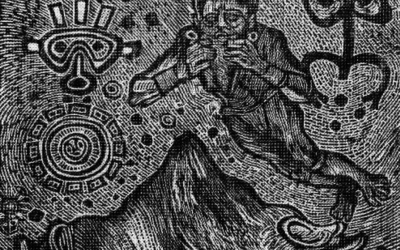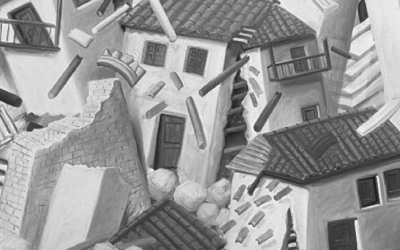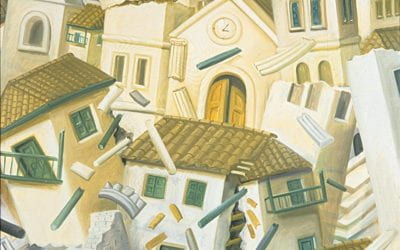Hurricane Isolated Villagers, but Solidarity Joined Them, and Us
“Where was the school?” I asked the teacher. He threw a small stone to the middle of the Savegre River,around 150 feet out. “Over there, over there was my school,” Marco Alvarez answered desolately. There was only a chunk of cement coming out of the turbulent and strident water.
He had taught in a one-room elementary school in Rio Blanco, an 18-family village in the mountains of Costa Rica’s central-pacific region. Alvarez had crossed many fresh avalanches and reached his students two days after Hurricane Cesar had destroyed the town, on July 28, 1996.
As a journalist for La Nación newspaper, I had met the teacher three weeks after the hurricane. A photographer, a firefighter and I had arrived at Rio Blanco after trekking through the mountainside for a whole day. In my newsroom, in San José, I had heard that several towns were still isolated. Nobody had written about what was happening there.
The river had surged to the middle of the village, pulling out three houses, including the teacher’s. Pieces of roof, walls and furniture were spread everywhere. Mud filled many other dwellings. The roads became swamps and the soccer field disappeared under tons of rocks and trunks.
“I burst into tears when I realized that the river had wiped away my little school, because it was one of the best in the area. It was a poor one, but well equipped. It had been built by the local people through our own effort,” Marco said.
Cesar didn’t hit Costa Rica directly. But its effects were ruinous: 40 people died, 1,417 homes destroyed, 170 bridges collapsed, 126 villages isolated. Losses reached more than US$200 million.
The catastrophe overwhelmed Costa Rican officials. They promised to help the village and sent, by helicopter, basic food, shovels and power saws. However, the government could do little with only three choppers, one borrowed from Honduras. In a poor country with no army, helicopters are a luxury, except when a disaster happens.
Marco was 52. He’d left his house in the city to teach in Rio Blanco. This plump and short underpaid teacher had quickly become a leader.
“My motivation is the children and the community. I cannot leave them behind. I will stay here,” Marco told me, while proudly showing me the tin panels his students had just installed to build a temporary school.
Cesar had turned the villagers’ pride into a skeleton of debris: a 200-foot long bridge that the Rio Blanco people had constructed by themselves after 10 years of planning. “Everybody here had worked a lot on that bridge and now we’ll have to start again,” said Arselio Mora, a 77-year-old founder of Rio Blanco.
To enter or leave Rio Blanco it was necessary to go through a dozen landslides, circle cliffs and balance on trunks that served as bridges. The families that lived there showed no fear of the risks. Ever since the heavy rains and the flood had damaged their village, they had worked together, clearing paths through the mountain.
With my notebook full of stories I was ready to go back. It was late, about 4 p.m. Our guide told us that he had found in the map a shortcut to another village about two hours away, where a car could pick us up.
We started to walk. Troubles came soon. The photographer twisted his ankle; the forest grew dark, rainy and foggy; we had no flashlight, no food, no water and we got lost.
To light our way we used the screen light of the photographer’s flash. We had to watch our steps to avoid abysses. We tied ourselves to each other with a string.
I felt irritated when I realized we could go from reporters to victims. We glimpsed a flickering light in the mountain and immediately changed course and began walking toward it. It was a small shack on the top of a hill.
At around 10 p.m. we knocked on the door and explained what was happening. A surprised man and his son welcomed us.
An avalanche had also washed away his little farm. His wife and his daughters had fled to another town. He and his boy had stayed to care for the house. They barely had any food but offered us coffee, a hot meal and a bed.
We sat together on the floor, enjoyed a bowl of soup by candlelight, and told stories of hurricanes and the people who see each other through them.
Winter 2007, Volume VI, Number 2
Mauricio Herrera is a Costa Rican journalist who writes for La Nación newspaper. As an investigative reporter, he has covered politics, human rights, and corruption issues. He is currently a Nieman fellow at Harvard University.
Related Articles
Editor’s Letter: Natural Disasters
We were little black cats with white whiskers and long tails. One musical number from my one and only dance performance—in the fifth grade—has always stuck in my head. It was called “Hernando’s Hideaway,” a rhythm I was told was a tango from a faraway place called Argentina.
After the Earthquake: Juan’s Life
Juan was a construction helper. He lived in Armenia, but his parents were from the Antioquia region, who had fled because of the violence there. The mother of his children was called…
Political Memory
Late in 1717 Dr. Joseph Surin, precentor of the Cathedral of Old Guatemala, carried out some calculations: had the mudslide that wiped the city on the 28th of August, feast day of Saint…




